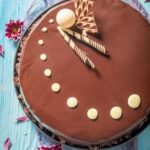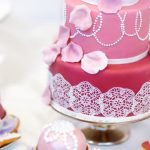Are you wondering how to decorate a sponge cakestrong> to perfection? Decorating a sponge cake is not only about making it visually appealing, but it also adds an extra layer of flavor and texture. In this article, we’ll explore the art of decorating a sponge cake, from choosing the right recipe to mastering various techniques and adding final touches for a professional finish.
A sponge cake is a light and airy dessert made with simple ingredients such as flour, eggs, sugar, and butter. It’s known for its delicate crumb and versatility as a base for different flavors and decorations. Decoration plays a crucial role in enhancing the overall appearance of the cake and can elevate its taste and presentation.
In this comprehensive guide, we will delve into the world of sponge cake decoration, covering everything from selecting the perfect recipe to troubleshooting common mistakes. Whether you’re new to baking or an experienced home baker looking to level up your skills, this article will provide you with valuable insights and practical tips for creating beautifully decorated sponge cakes that are sure to impress.
Choosing the Right Sponge Cake Recipe
Consider Your Preferences
Before choosing a sponge cake recipe, consider your flavor preferences and the theme of your event. If you’re aiming for a light and airy dessert, a traditional sponge cake made with eggs, flour, sugar, and vanilla extract may be the perfect choice. On the other hand, if you want to add richness and depth to your cake, opt for a chocolate sponge recipe that includes cocoa powder or melted chocolate.
Pay Attention to Texture
When selecting a sponge cake recipe, pay attention to the desired texture of your finished product. Some recipes may produce a denser and more moist sponge, while others will result in a lighter and fluffier texture. Consider the type of filling and frosting you plan to use, as well as any decorative elements, as these factors will impact the overall mouthfeel of your cake.
Test Before the Big Day
Once you’ve chosen a recipe for your sponge cake base, don’t wait until the day of your event to test it out. Bake a small sample batch ahead of time to ensure that the texture, flavor, and appearance meet your expectations. This will also give you an opportunity to make any adjustments or modifications before committing to your final cake creation.
Essential Tools for Decorating a Sponge Cake
Decorating a sponge cake can be a fun and rewarding experience, but having the right tools is essential to ensure a professional-looking result. From piping bags to offset spatulas, the proper equipment can make all the difference in creating a beautifully decorated cake that will impress your friends and family.
One of the most important tools for decorating a sponge cake is the piping bag. Piping bags allow you to create intricate designs and patterns with frosting or icing, giving your cake a polished and professional appearance. There are various types of piping bags available, including disposable plastic bags and reusable cloth or silicone bags. It’s important to choose a piping bag that feels comfortable in your hand and suits your decorating style.
Another essential tool for decorating a sponge cake is an offset spatula. This versatile tool is perfect for spreading frosting or icing evenly across the surface of the cake, as well as for creating smooth edges and sharp corners. The offset design allows you to keep your hands away from the cake while maintaining precision and control over your decorating technique.
| Essential Tools | Description |
|---|---|
| Piping Bag | An essential tool for creating intricate designs with frosting or icing. |
| Offset Spatula | Versatile tool for spreading frosting or icing evenly across the cake surface. |
In addition to piping bags and offset spatulas, other useful tools for decorating a sponge cake include turntables for easy maneuverability while working on the cake, as well as various types of pastry tips for creating different designs with frosting. By investing in high-quality tools, you’ll be better equipped to produce professional-looking decorations on your sponge cakes every time.
Decorating Techniques
Decorating a sponge cake is an exciting and creative process that allows you to showcase your baking skills and artistic flair. There are various techniques and options for decorating a sponge cake, including using buttercream frosting, fondant, and fresh fruit. Each method offers a different aesthetic and flavor profile, so choosing the right one for your cake is crucial.
When it comes to decorating techniques for sponge cakes, there are several options to consider:
- Buttercream Frosting: Buttercream is a classic choice for decorating sponge cakes due to its smooth texture and versatility. It can be easily piped into decorative patterns, or used to create intricate designs.
- Fondant: Fondant is a popular choice for creating sleek and polished cake designs. It can be rolled out and draped over the cake, providing a smooth canvas for intricate decorations.
- Fresh Fruit: For a lighter and refreshing option, consider using fresh fruit to decorate your sponge cake. Berries, sliced kiwi, or edible flowers can add a pop of color and natural sweetness to your creation.
Each technique requires different skills and tools, so it’s essential to choose the one that best suits your abilities and desired outcome. Whether you prefer the rich taste of buttercream frosting, the elegant look of fondant, or the freshness of fresh fruit, mastering these decorating techniques will elevate your sponge cake to new heights of visual appeal.
Experimenting with different decorating methods can also add variety to your baking repertoire and allow you to personalize each cake based on the occasion or recipient. Keep in mind that practice makes perfect when it comes to decorating techniques, so don’t be afraid to get creative and try new ideas with each sponge cake you decorate.
Step-by-Step Guide to Piping Techniques
Piping techniques are an essential part of decorating a sponge cake, as they add intricate and beautiful designs to the cake’s surface. Learning how to use a piping bag effectively can take your cake decoration skills to the next level. There are several popular piping techniques that can be used to create stunning designs, including rosettes, swirls, and borders.
Rosettes
Rosettes are a classic piping technique that adds a touch of elegance to any sponge cake. To create rosettes, start by fitting a piping bag with a star-shaped piping tip. Hold the bag at a 90-degree angle to the surface of the cake and using steady pressure, pipe small concentric circles while moving your wrist in a circular motion. This will create a beautiful rose-like design on the cake.
Swirls
Swirls are another popular piping technique that can add visual interest to your sponge cake. To pipe swirls, fit your piping bag with a round or star-shaped tip and hold it at a 45-degree angle to the surface of the cake. Apply even pressure to the bag while moving it in a circular motion to create elegant swirl designs on the cake.
Borders
Borders are used to frame the edges of the cake and give it a polished look. There are many different styles of borders that can be piped onto a sponge cake, including shell borders, rope borders, and bead borders. Each border style requires different tips and techniques for creating clean and professional-looking edges.
Overall, mastering these piping techniques can take some practice but once you get the hang of it, you’ll be able to create beautifully decorated sponge cakes that are sure to impress everyone who sees them.
Using Edible Decorations
Decorating a sponge cake with edible decorations can add a pop of color, texture, and flavor to your creation. Whether you’re making a cake for a birthday, special occasion, or just for a sweet treat, using edible decorations can take your sponge cake to the next level. Here are some popular edible decorations you can use to enhance the appearance and taste of your sponge cake:
- Sprinkles: Colorful sprinkles are a classic choice for adding a fun and festive touch to a sponge cake. You can choose from a wide variety of shapes, colors, and sizes to suit the theme of your cake.
- Edible Flowers: Fresh edible flowers such as roses, violets, or pansies can be used to create an elegant and natural look for your sponge cake. Not only do they add beauty, but they also provide a subtle floral flavor.
- Chocolate Shavings: Chocolate shavings not only provide visual appeal but also add delicious chocolatey goodness to your sponge cake. You can use dark, milk, or white chocolate shavings depending on your preference.
When using edible decorations on your sponge cake, it’s important to consider the flavor profiles and textures to ensure they complement the overall taste and mouthfeel.
In addition to these popular options, there are many other edible decorations you can incorporate into your sponge cake design based on personal preference and creativity. From candied fruit to macarons, the possibilities are endless when it comes to adding edible embellishments to your beautifully decorated sponge cake.
Tips for Creating a Professional Finish
Creating a professional finish on your sponge cake is essential for a visually appealing and well-executed dessert. Smoothing, stacking, and leveling are key techniques that can elevate the overall look of your cake, making it appear polished and high-quality.
To achieve a smooth finish on your cake, it’s important to start with properly leveled layers. Using a long serrated knife or a cake leveler, carefully trim the tops of your cake layers to ensure they are even. This will prevent any unevenness in the final appearance of your cake.
Once stacked, use an offset spatula to apply a thin layer of buttercream frosting or ganache around the sides and top of the cake to create a crumb coat. Chill the cake for about 15 minutes to set this initial layer before applying the final coat of frosting.
When stacking multiple layers of sponge cake, it’s crucial to ensure that each layer is placed evenly on top of the other. Use a turntable for easy maneuvering and make adjustments as needed to keep everything aligned. To maintain stability while stacking, consider using dowels or straws inserted into the bottom layers to support the upper tiers, especially for taller cakes.
Leveling is also important when adding decorations such as fondant or fresh fruit. A perfectly leveled cake not only looks refined but also provides a stable base for any additional embellishments you may want to include. Taking care in these techniques will result in a professionally finished sponge cake that is sure to impress both visually and taste-wise.
| Technique | Importance |
|---|---|
| Smoothing | Creates a polished appearance |
| Stacking | Ensures stability and even distribution |
| Leveling | Serves as a strong foundation for decorations |
Troubleshooting Common Decorating Mistakes
Decorating a sponge cake can be a delightful and rewarding experience, but it can also come with its challenges. Common decorating mistakes such as cracks, soggy layers, and uneven frosting can often deter bakers from achieving the perfect finish. However, with the right techniques and know-how, these issues can be easily avoided or rectified.
One of the most common problems when decorating a sponge cake is dealing with cracks on the surface. Cracking can occur due to overmixing the batter, uneven baking, or rapid temperature changes during cooling. To prevent cracking, make sure to gently fold the dry ingredients into the wet ones until just combined and avoid overbaking the cake. If you do encounter cracking, don’t worry – you can use extra frosting or decorative elements to cover them up.
Another common issue when decorating sponge cakes is dealing with soggy layers. This usually happens when the cake is not properly cooled before frosting or when too much filling is added, causing it to seep into the cake layers. To avoid this problem, make sure your cake layers are completely cooled before adding any frosting or filling. Additionally, you can create a dam of thicker frosting around the edges of each layer to prevent any fillings from leaking out.
Uneven frosting is another challenge that many bakers face when decorating sponge cakes. Achieving a smooth and even coat of frosting can be tricky, especially for beginners.
Using an offset spatula and bench scraper can help in spreading and smoothing out the frosting evenly on the cake’s surface. If you still struggle with achieving professional-looking results, consider using a crumb coat – a thin layer of frosting applied before the final coat – to seal in any loose crumbs and create a smooth base for your final layer of icing.
By being mindful of these common decorating mistakes and implementing the right techniques to avoid or troubleshoot them, you will be well on your way to creating beautifully decorated sponge cakes that are sure to impress both visually and taste-wise.
Final Touches
In conclusion, decorating a sponge cake can be a rewarding and enjoyable experience, and the final touches are essential to showcasing your beautifully decorated creation. Presentation is key when serving a sponge cake, so consider using a decorative cake stand or platter to display your masterpiece. Adding fresh fruit or edible flowers as a garnish can also enhance the visual appeal of your cake and make it even more appetizing.
When it comes to serving your sponge cake, remember to use a sharp serrated knife for clean slices. This will help maintain the integrity of the decorations and ensure that each slice looks just as stunning as the whole cake.
Additionally, storing your decorated sponge cake properly is crucial for maintaining its freshness and appearance. If using buttercream frosting, it’s best to keep the cake refrigerated but allow it to come to room temperature before serving to ensure that the texture is just right.
Lastly, don’t forget to take pride in your beautifully decorated sponge cake and share it with friends and family. Whether you’re celebrating a special occasion or simply indulging in a sweet treat, the effort put into decorating your sponge cake is sure to be appreciated by all who get to enjoy it. So go ahead, take a step back, admire your work, and savor every delicious bite of your stunning creation.
Frequently Asked Questions
How Do You Jazz Up a Sponge Cake?
Jazzing up a sponge cake can be done in many ways. One popular method is to add flavorings to the cake batter, such as vanilla extract, almond extract, or citrus zest.
Another way is to fill the cake with a layer of fruit preserves, flavored whipped cream, or even a chocolate ganache. Garnishing the finished cake with fresh fruit, edible flowers, or a dusting of powdered sugar can also add flair.
What Do You Put on a Sponge Cake Before Icing?
Before icing a sponge cake, it’s common to spread a thin layer of jam or jelly on the top of each layer. This not only adds flavor but also helps keep the cake moist. Some people also like to brush the cake layers with a sugar syrup infused with flavorings like vanilla or citrus before adding the icing.
How Do You Decorate the Top of a Victoria Sponge?
Decorating the top of a Victoria Sponge typically involves sprinkling powdered sugar over the assembled cake just before serving. Alternatively, some may choose to top it with fresh fruit such as berries or sliced peaches for a simple yet elegant finishing touch. For special occasions, piping whipped cream rosettes or frosting flowers can make for a more elaborate decoration.

Welcome to my blog about home and family. This blog is a place where I will share my thoughts, ideas, and experiences related to these important topics. I am a stay-at-home mom with two young children. I hope you enjoy reading it! and may find some helpful tips and ideas that will make your home and family life even better!





